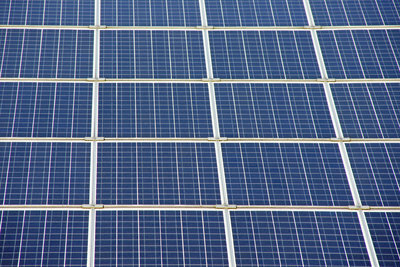How is a solar cell constructed?
Renewable energy is becoming more and more important. Almost a whole quarter of Germans, for example, already use solar energy. But do you actually know how a solar cell is constructed and how it works?

How the solar cell works
- First of all, you should know that solar cells make use of the photovoltaic effect. The cells are constructed from treated semiconductor materials, whereby they absorb light that occurs in certain wavelengths energy can convert.
- The most popular material for this process is high purity silicon. In a solar cell you will find this as wafers, with those wafers ultimately functioning as semiconductor material. At the top, the wafers are enriched with phosphorus atoms, while at the bottom they are reinforced with boron atoms, so that an electric field occurs in their center.
- In this way, free charge carrier pairs are formed during irradiation. Because there is an electric field inside the solar cells, those charge carrier pairs separate well, with the negative particles moving upwards while the positive elements are moving downwards collect. The result is a direct voltage between the upper and lower surface of the solar cells.
This is how the cell is built
- As you already know, the classic solar cell is made of silicon. More precisely, it is composed of a 0.001 mm thick n-layer, which is located in the middle of the p-conducting, 0.6 mm thick Si substrate, which is intended to stabilize the cell. Between the n-layer and the p-conducting Si substrate lies the boundary layer of the cell, which can be passed by the charge when light is incident.
- You will have heard it before: The solar cell can only function because its two layers are doped differently. In simple terms, this means that approx. 1019 Phosphorus atoms / cm³ are introduced into the Si substrate. Thanks to these atoms, the solar cell remains electrically neutral on the outside. In the second layer of the cell, on the other hand, there are trivalent boron atoms, while the boundary layer remains undoped and is easily passable for electrons and holes, i.e. the charge.
- So that you, the consumer, can benefit from the energy converted by the cell, there are metallic contacts on the front and back of each solar cell. These are preferably made of aluminum or silver. On the back there is usually a contact layer applied over the entire surface, while there is a kind of grid on the front to give the light a larger surface to attack.
- Finally, silicon nitride plays a role in the structure of the cell. This is vaporized onto the surface of the cell in order to avoid reflections of the light.
Solar panel - just do it yourself
A solar panel, as you know it from specialist retailers, is just easy to build yourself ...
With this knowledge you may not be a solar energy expert, but at least you now know roughly how the cells work and how they are roughly structured. That is at least more than 90 percent of the average solar cell user know.
How helpful do you find this article?



